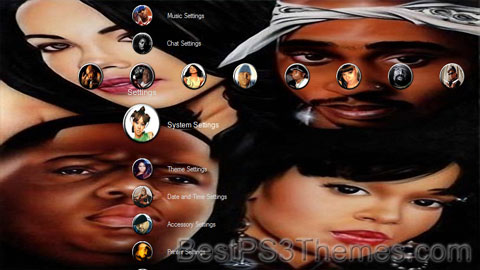Buckethead theme by Wingsofbacon
Download: Buckethead.p3t
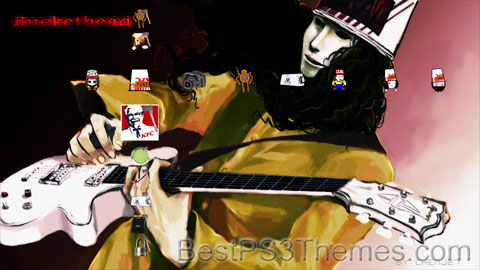
(7 backgrounds)
Buckethead | |
|---|---|
 Buckethead performing in 2008 | |
| Background information | |
| Birth name | Brian Patrick Carroll |
| Also known as | |
| Born | May 13, 1969[3] Pomona, California, U.S. |
| Genres | |
| Occupation(s) |
|
| Instrument(s) | Guitar |
| Years active | 1987–present |
| Labels |
|
| Formerly of | Deli Creeps, Praxis, Cornbugs, El Stew, Guns N' Roses, Thanatopsis, Colonel Claypool's Bucket of Bernie Brains, The Frankenstein Brothers, Science Faxtion |
| Website | bucketheadpikes |
Brian Patrick Carroll (born May 13, 1969), known professionally as Buckethead, is an American guitarist, songwriter, and multi-instrumentalist. He has received critical acclaim for his innovative virtuoso electric guitar playing.[4] His music spans several genres, including progressive metal, funk, blues, bluegrass, ambient, and avant-garde music. He performs primarily as a solo artist, although he has collaborated with a wide variety of artists such as Bill Laswell, Bootsy Collins, Bernie Worrell, Iggy Pop, Les Claypool, Serj Tankian, Bill Moseley, Mike Patton, Viggo Mortensen, That 1 Guy, and Skating Polly. He was also a member of Guns N' Roses from 2000 to 2004. He has released over 700 albums and has performed on over 50 albums by other artists. Buckethead has written and performed music for major motion pictures, including Saw II, Ghosts of Mars, Beverly Hills Ninja, Mortal Kombat, Mortal Kombat: Annihilation, Last Action Hero, Falling, and contributed lead guitar to the track "Firebird" featured on the Mighty Morphin Power Rangers: The Movie soundtrack.
Buckethead performs wearing a KFC bucket on his head, sometimes emblazoned with an orange bumper sticker reading FUNERAL in block letters. This is accompanied by an expressionless plain white mask inspired by the 1988 slasher film Halloween 4: The Return of Michael Myers.[5] He also incorporates nunchaku and robot dancing into his stage performances.[6][7][8]
Buckethead was credited by Guitar World as "ushering in [a] new era of virtuosity" while ranking the release of his 1992 debut album Bucketheadland the 45th greatest moment in electric guitar history.[9] The magazine has also listed him among the "25 all-time weirdest guitarists"[10] and the "50 fastest guitarists of all time".[11]
Early and personal life[edit]
Brian Patrick Carroll was born on May 13, 1969, to Tom and Nancy Carroll; he is the youngest of five siblings along with Lynn, Lisa, Lori, and John.[12] His father was the athletic director at Damien High School in La Verne, California from 1973 until his retirement in 2013.[13]
Carroll grew up in a Southern California suburb near Disneyland. In his youth he was an introvert and spent most of his time in his room with books, games, martial-arts movie memorabilia, and toys. He also spent a lot of time at Disneyland.[5]
Carroll began playing guitar at the age of 12. He learned to play from an elderly man down his road. He is quoted saying that he became serious a year later after moving from Huntington Beach, California, to Claremont. His playing improved with lessons from various teachers at a local music store. His early teachers included Max McGuire, Johnny Fortune, Mark Hammond, Pebber Brown, Joey Tafolla, and Paul Gilbert. In 2003, Buckethead played a tribute to all his early teachers as the Deli Creeps played a show at Styles Music's 25th anniversary. He then began making demo recordings of both his playing as well as his writing styles, which would later be released in 2007–2008.[citation needed]
The Buckethead persona came to be when Carroll saw the 1988 slasher film Halloween 4 and was inspired by the film. He went out right after seeing it and bought a Michael Myers-like white mask. The bucket idea came later that night while eating chicken:[14]
I was eating it, and I put the mask on and then the bucket on my head. I went to the mirror. I just said, 'Buckethead. That's Buckethead right there.' It was just one of those things. After that, I wanted to be that thing all the time.
— Buckethead, 1996, Guitar Player Magazine [5]
In October 2017, Carroll gave a rare out-of-character interview discussing all ranges of his life, the Buckethead character, his parents' deaths, his health problems, and how he copes with overcoming fear.[14] During the podcast, he revealed he has been diagnosed with the potentially life-threatening condition of heart arrhythmia. He stated he had a cardiac ablation performed and uses medicine to control the problem.[15]
Career[edit]
1988–1994: Early solo career and Praxis[edit]
In 1988, after leaving the band Class-X, Carroll entered a song called "Brazos" into a Guitar Player magazine contest. It was a runner-up, with editors writing:
An astonishingly skilled guitarist and bassist, he demonstrates post-Paul Gilbert speed and accuracy filtered through very kinky harmonic sensibilities. His psychotronic, demonic edge is very, very far removed from the clichés of classical metal and rock. A real talent to watch, also known as "Buckethead."[16]
In the same year, the magazine's editor, Jas Obrecht, came to know of Buckethead when Carroll and his parents left a demo recording at the magazine's reception desk for Obrecht. Impressed with this demo, he rushed into the restaurant where Buckethead and his parents were having lunch and encouraged him to make the most of his talent.[17] They soon became friends. In 1989, a song called "Soowee" by Buckethead got honorable mention in another song contest. In 1991, Buckethead moved into Obrecht's basement. The song "Brazos" was eventually released on the 1991 demo tape of his band Deli Creeps, titled "Tribal Rites", and again as bonus material in Buckethead's Secret Recipe DVD in 2006. Luke Sacco was his teacher.
In 1991, Buckethead contributed to Derek Bailey's Company project alongside, among others, John Zorn and Alexander Bălănescu, resulting in a triple album called Company 91.
After his first two demo tapes, called Giant Robot and Bucketheadland Blueprints, Buckethead released Bucketheadland on John Zorn's Japanese Avant record label in 1992. Though available only as a pricey import, the record received positive reviews and earned some attention. At about this time, Buckethead fell into the orbit of prolific bassist/producer Bill Laswell, himself an occasional Zorn collaborator; Buckethead (as a performer, producer, or composer) was introduced to Laswell with the help of Limbomaniacs drummer Bryan "Brain" Mantia, who gave Laswell a video of Buckethead playing in his room.[18] Buckethead soon became Laswell's second staple guitar player, besides Nicky Skopelitis.
In 1992, Buckethead, with Bill Laswell, Bernie Worrell, Bootsy Collins, and Bryan "Brain" Mantia, formed the supergroup Praxis. Their first album, Transmutation (Mutatis Mutandis), released the same year, was well received. The project was Bill Laswell's concept, and has since involved other guests such as Serj Tankian of System of a Down, among many others. Buckethead participated in every release except the initial 1984 release and Mold (1998).
In 1993, Buckethead auditioned to play for the Red Hot Chili Peppers. The band eventually ended up with Arik Marshall,[19] and later Dave Navarro. After some legal complications with Sony Music Entertainment, Buckethead decided to release his 1994 album Dreamatorium under the name of Death Cube K (an anagram).
Death Cube K is a separate entity that looks like a photographic negative version of Buckethead with a black chrome mask, like Darth Vader. This apparition haunts Buckethead and appears in his nightmares.[20]
Buckethead released a second studio album that year, Giant Robot, which features many guest appearances by artists such as Iggy Pop and Bill Moseley. The name of the album came from the Japanese series Johnny Sokko and his Flying Robot, of which Buckethead is a fan.[21] He also released two other albums with Praxis, their second and third studio efforts: Sacrifist and Metatron.
1995–1999: Collaboration work, movie soundtracks and Praxis[edit]
In 1995, Buckethead did not release any solo albums but collaborated with several artists like Jonas Hellborg and Michael Shrieve (Octave of the Holy Innocents). He also contributed to several movie soundtracks, such as Johnny Mnemonic and Mortal Kombat.
Later, in 1996, Buckethead released his solo album The Day of the Robot with the help of English producer DJ Ninj and Laswell, plus another album with Brain and keyboardist Pete Scaturro on the small Japanese label NTT Records, called Giant Robot. Both albums were printed only in small quantities and are collectors' items now. A second demo tape by the Deli Creeps was also recorded.
Also in 1996, several Sega Saturn television ads featuring a screaming mask-like face pressing through the blue orb of the Saturn logo was released, with music by Buckethead.
In 1997, Buckethead began working on the album Buckethead Plays Disney, but the album has not yet been released. According to his Web page:
This highly anticipated album, once listed in an Avant catalog, has yet to be completed. It is Buckethead's most precious personal project, so he won't record or release it until he knows he is ready.[22]
Also in 1997, Buckethead continued to contribute to movie soundtracks, appearing on Beverly Hills Ninja and Mortal Kombat: Annihilation, the sequel to Mortal Kombat.
Further releases were Arcana's second and final studio album Arc of the Testimony in which he played with noted drummer Tony Williams and the one-off project Pieces, with Brain. Two live albums by Praxis, called Transmutation Live and Live in Poland (featuring recordings from European concerts) were also issued.
Death Cube K released an album that year called Disembodied.
In 1998, Buckethead released Colma, an album dedicated to his mother, who at the time was suffering from colon cancer.[23] A compilation album by Praxis called Coll ction also came out that year.
In 1999, Buckethead released his fifth album, a collaboration with Les Claypool from the band Primus, titled Monsters and Robots—currently the best-selling album of his career. The album includes the song "The Ballad of Buckethead", for which his first music video ever was made.[24] Buckethead began three new projects that year, the first being the band Cornbugs, a collaboration with actor Bill Moseley, drummer Pinchface, and later keyboardist Travis Dickerson. Another project, Cobra Strike with an album called The 13th Scroll, featured Pinchface, Bryan "Brain" Mantia, DJ Disk, and Bill Laswell. Buckethead also began a collaboration with actor Viggo Mortensen, whom he first met through a recording project called Myth: Dreams of the World[25] in 1996. Together they released One Man's Meat, One Less Thing to Worry About, and The Other Parade. Buckethead contributed to the 1999 album Devil Dub by the San Francisco Bay Area band Ben Wa consisting of "Dr. Ware" and "House"(Limbomaniacs, Tommy Guerrero, Buckethead's Giant Robot, MCM & the Monster).[26]
2000–2004: Guns N' Roses and other projects[edit]
Buckethead achieved a higher public profile as lead guitarist for Guns N' Roses from 2000 to 2004.[27] He recorded the often-delayed album Chinese Democracy with the band and appeared live on stage in 2001 and 2002, including Rock in Rio 3, MTV's Video Music Awards, and parts of the Chinese Democracy Tour. His guitar solo on "There Was a Time" received acclaim, with several publications listing it amongst the best solos of the decade.[28][29][30]
Despite being a member of GN'R, Buckethead released his sixth studio album, called Somewhere Over the Slaughterhouse in 2001, and also his only EP, called KFC Skin Piles. He also released two albums with his band Cornbugs, and a third under his 'Death Cube K' pseudonym. In 2000, Buckethead released the second and last album by Cobra Strike, called Cobra Strike II - Y, Y+B, X+Y. He joined two new projects during this period. The first was the progressive rock band Thanatopsis (named after a poem by William Cullen Bryant[31]) with Travis Dickerson and drummer Ramy Antoun;[32] this group went on to release four albums. Some Thanatopsis material has also appeared on albums released by Buckethead and Dickerson.[33] Buckethead's second side project during this period was with Bill Laswell and Japanese producer Shin Terai, released as the album Unison.
In 2002, Buckethead released three studio albums: Funnel Weaver, a collection of 49 short tracks, Bermuda Triangle, and finally, Electric Tears, a calming album that is similar to his earlier release, Colma. When Laswell was not able to play with Praxis at the Bonnaroo Music and Arts festival, Les Claypool asked to jam with Brain, Bernie Worrell, and Buckethead, forming a new supergroup called Colonel Claypool's Bucket of Bernie Brains. The jamband experiment was successful enough to do some further live dates.
Later, in 2003, marking the release of his tenth studio album, Buckethead released the sequel of his debut Bucketheadland, simply called Bucketheadland 2. Together with actor Viggo Mortensen, he did Pandemoniumfromamerica, and with Thanatopsis, its second release, called Axiology.
Buckethead's relationship with Guns N' Roses was somewhat erratic in its last year, despite contractual obligations. According to an interview with Rose, he seemingly 'left' the band in January 2004 without telling anyone, and 'rejoined' in a similar manner in February. "His transient lifestyle has made it impossible for even his closest friends to have nearly any form of communication with him whatsoever."[34] In March 2004, Buckethead left Guns N' Roses. His manager cited Guns' inability to complete an album or tour.[35]
Since that time, his cult following in the underground music communities has steadily increased. He frequently performs at festivals and in clubs nationwide and often tours as the feature performer.[36][37]
The year 2004 saw the release of three new studio albums: Island of Lost Minds, which was his first tour-only album being later re-released by TDRS Music; Population Override, a blues-rock tour de force with Dickerson; and The Cuckoo Clocks of Hell, considered his heaviest effort to date. The latter includes "Spokes for the Wheel of Torment," for which Syd Garon and Eric Henry made a music video based on the famous triptychs by Hieronymus Bosch. Buckethead also recorded the final two albums by the Cornbugs, Brain Circus and Donkey Town as well as another release with Viggo Mortensen called Please Tomorrow and a second with Shin Terai, titled Heaven & Hell. C2B3 also released their only album, The Big Eyeball in the Sky, and toured it in North America.
In an interview with Revolver, Ozzy Osbourne said that he had offered to have Buckethead play guitar in his band at Ozzfest, but changed his mind after meeting with him and realizing that he would not remove his costume:
"I tried out that Buckethead guy. I met with him and asked him to work with me, but only if he got rid of the fucking bucket. So I came back a bit later, and he's wearing this green fucking Martian's-hat thing! I said, 'Look, just be yourself.' He told me his name was Brian, so I said that's what I'd call him. He says, 'No one calls me Brian except my mother.' So I said, 'Pretend I'm your mum, then!' I haven't even got out of the room and I'm already playing fucking mind games with the guy. What happens if one day he's gone and there's a note saying, 'I've been beamed up'? Don't get me wrong, he's a great player. He plays like a motherfucker."[38]
2005–2006: Buckethead & Friends[edit]
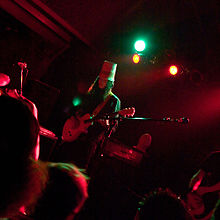
In 2005, Buckethead released the album Enter the Chicken through Serj Tankian's record label, Serjical Strike. The album features Tankian himself, Maximum Bob (of the Deli Creeps), Death by Stereo singer Efrem Shulz, Bad Acid Trip and others.[39] It is marked by its leaning toward more traditional song structures while still featuring typical Buckethead guitar skills. "We Are One" was released as a single and also appeared on the soundtrack of Masters of Horror. "Three Fingers" was used for the soundtrack of the horror movie Saw II. The final track, "Nottingham Lace", was first made public via his home page and soon became a concert staple and one of his most popular songs. Buckethead also released two further solo albums in 2005, Kaleidoscalp and Inbred Mountain—the latter being the first album as a solo artist released on the label TDRS Music. Both albums originally were sold exclusively at concerts and only later got an official release through the label's website.
Buckethead released albums with other bands that year: with Cornbugs, he released two compilation albums, called Rest Home for Robots and Skeleton Farm. Gorgone's self titled album was released that year' itself based upon recording sessions from the album Population Override that Buckethead released in 2004.
In 2006, the cross-console video game Guitar Hero II was launched, featuring Buckethead's song "Jordan" as an unlockable bonus track. Although the song has been performed live in the past, the video game version is the only known studio recording of the song. When playing it live, Buckethead would almost always simply perform the verse and chorus of "Jordan" before transitioning into the next song. However, the Guitar Hero II version contains a special solo created specifically for the game.[40]
Also the same year, Buckethead released two DVDs, titled Young Buckethead Vol. 1 and Young Buckethead Vol. 2, featuring rare footage from 1990 and 1991. The DVD also contains three complete Deli Creeps shows, a sound check, backstage footage, and solo footage of just Buckethead. He also released the albums The Elephant Man's Alarm Clock and Crime Slunk Scene, both sold on his tours but later sold on the TDRS Music website. The last album has the song "Soothsayer (Dedicated to Aunt Suzie)"; this song (along with "Jordan" and "Nottingham Lace") is one of his most popular songs and is often played live. Buckethead released his final compilation album with the band Cornbugs, called Celebrity Psychos. He also released an album with Travis Dickerson, called Chicken Noodles, a move that would see the start of a four-year long collaboration with the keyboardist. Buckethead's band Thanatopsis would also release Anatomize that year.
2007–2010: Continued solo work and Michael Jackson tribute[edit]

In 2007, Buckethead released an unprecedented amount of new material. In February, a box set titled In Search of The, containing 13 albums of original material, was released. It was handcrafted, numbered, and monogrammed by Buckethead and contained over nine hours of music. A regular solo album, called Pepper's Ghost, was released in March. A disc of acoustic improvisations called Acoustic Shards was also released, becoming the twentieth studio album that the artist had released so far in his solo career. In midyear, he reissued his demo tape Bucketheadland Blueprints, with two alternative album co
Nine Inch Nails
Nine Inch Nails theme by TTownEP
Download: NineInchNails.p3t
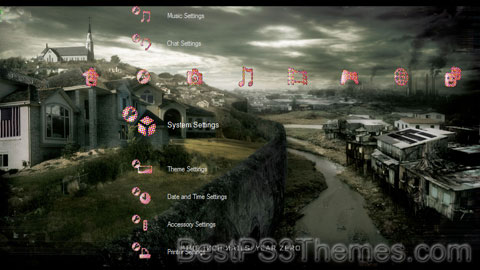
(11 backgrounds)
Nine Inch Nails | |
|---|---|
 Atticus Ross (left) and Trent Reznor (right) performing in October 2018 | |
| Background information | |
| Origin | Cleveland, Ohio, U.S. |
| Genres | |
| Discography | |
| Years active | 1988–present |
| Labels |
|
| Members | |
| Past members | List of Nine Inch Nails band members |
| Website | nin |
Nine Inch Nails, commonly abbreviated as NIN, stylized as NIИ, is an American industrial rock band formed in Cleveland in 1988. Singer, songwriter, multi-instrumentalist, and producer Trent Reznor was the only permanent member of the band until his frequent collaborator, Atticus Ross, joined in 2016. The band's debut album, Pretty Hate Machine (1989), was released via TVT Records. After disagreeing with TVT about how to promote the album, the band signed with Interscope Records and released the EP Broken (1992). The following albums, The Downward Spiral (1994) and The Fragile (1999), were released to critical acclaim and commercial success.
Following a hiatus, Nine Inch Nails resumed touring in 2005 and released their fourth album With Teeth (2005). Following the release of the next album Year Zero (2007), the band left Interscope after a feud. Nine Inch Nails continued touring and independently released Ghosts I–IV (2008) and The Slip (2008) before a second hiatus. Their eighth album, Hesitation Marks (2013), was followed by a trilogy which consisted of the EPs Not the Actual Events (2016) and Add Violence (2017) and their ninth album Bad Witch (2018). In 2020, Nine Inch Nails simultaneously released two further installments in the Ghosts series: Ghosts V: Together and Ghosts VI: Locusts.
When touring, Reznor typically assembles a live band to perform with him under the Nine Inch Nails name. This live band has varied over the decades, with various members leaving and returning; the most recent lineup consists of Robin Finck (who initially joined in 1994), Alessandro Cortini (who initially joined in 2005), and Ilan Rubin (who initially joined in 2008) alongside Reznor and Ross. The band's concerts are noted for their extensive use of thematic visual elements, complex special effects, and elaborate lighting. Songs are often rearranged to fit any given performance, and melodies or lyrics of songs that are not scheduled to be performed are sometimes assimilated into other songs.
Nine Inch Nails have sold over 20 million records and been nominated for 13 Grammy Awards, winning for the songs "Wish" in 1992 and "Happiness in Slavery" in 1996. Time magazine named Reznor one of its most influential people in 1997, while Spin magazine has described him as "the most vital artist in music". In 2004, Rolling Stone placed Nine Inch Nails at No. 94 on its list of the 100 greatest artists of all time. Nine Inch Nails were inducted into the Rock and Roll Hall of Fame in 2020, after being nominated in 2014 (their first year of eligibility) and again in 2015.
History[edit]
Formation (1987–1988)[edit]

While living in Cleveland in 1987, Trent Reznor played keyboards in the Exotic Birds, a synthpop band managed by John Malm Jr.[1]: 38 Reznor became friends with Malm,[2] who informally became his manager when he left to work on his own music.[3] At the time, Reznor was employed as an assistant engineer and janitor at Right Track Studios.[4] Studio owner Bart Koster granted Reznor free access to the studio between bookings to record demos,[5][6] commenting that it cost him nothing more than "a little wear on [his] tape heads".[7] Unable to find a band that could articulate the material as he desired, Reznor was inspired by Prince to play all instruments himself except drums, which he programmed electronically.[8] He has continued to play most parts on Nine Inch Nails recordings ever since.[2]
The first Nine Inch Nails performance took place at the Phantasy Theater in Lakewood, Ohio, on October 21, 1988.[9] Soon after, following their live support of Skinny Puppy, Reznor aimed to release one 12-inch single on a small European label.[10] Several labels responded favorably to the demo material and Reznor signed with TVT Records.[4] Nine demos, recorded live in November 1988 and collectively known as Purest Feeling, were released in revised form on the first studio album, Pretty Hate Machine (1989).[1]: 41 The overall sound on Purest Feeling is lighter than that of Pretty Hate Machine; several songs contain more live drumming and guitar, as well as a heavier use of film samples.[11]
Reznor chose the name "Nine Inch Nails" because it "abbreviated easily" rather than for "any literal meaning".[12] Other rumored explanations have circulated, alleging that Reznor chose to refer to Jesus's crucifixion with nine-inch spikes,[13]: 57 or Freddy Krueger's nine-inch fingernails.[14] The Nine Inch Nails logo first appeared on the music video for their debut single, "Down in It". Reznor and Gary Talpas designed the logo, inspired by Tibor Kalman's typography on the Talking Heads album Remain in Light.[15][16] The logo features the band's initials, with the second N mirrored. Talpas, a native of Cleveland, continued to design Nine Inch Nails packaging until 1997.[17]
Pretty Hate Machine (1988–1991)[edit]
Written, arranged, and performed by Reznor,[18] Nine Inch Nails' first album Pretty Hate Machine debuted in 1989.[19] It marked his first collaboration with Adrian Sherwood (who produced the lead single "Down in It" in London without meeting Reznor face-to-face)[10] and Mark "Flood" Ellis.[1]: 42 Reznor asked Sean Beavan to mix the demos of Pretty Hate Machine, which had received multiple offers for record deals.[20] He mixed sound during Nine Inch Nails' live concerts for several years,[21] eventually becoming an unofficial member of the live band and singing live backup vocals from his place at the mixing console.[22] Flood's production would appear on each major Nine Inch Nails release until 1994, and Sherwood has made remixes for the band as recently as 2000. Reznor and his co-producers expanded upon the Right Track Studio demos by adding singles "Head Like a Hole" and "Sin".[23] Rolling Stone's Michael Azerrad described the album as "industrial-strength noise over a pop framework" and "harrowing but catchy music";[24] Reznor proclaimed this combination "a sincere statement" of "what was in [his] head at the time".[25] In fact, the song "Down in It" spent over two months on Billboard's club-play dance chart.[26] After spending 113 weeks on the Billboard 200,[27] Pretty Hate Machine became one of the first independently released records to attain platinum certification.[4]

Three music videos were created in promotion of the album. MTV aired the videos for "Down in It" and "Head Like a Hole", but an explicit video for "Sin" was only released in partial form for Closure. The original version of the "Down in It" video ended with the implication that Reznor's character had fallen off a building and died in the street.[28] This footage attracted the attention of the FBI.[29]
In 1989, while doing promotion for the album, the band members were asked on what shows they would like to appear. They jokingly replied (possibly while intoxicated) that they would like to appear on Dance Party USA, since it was the most absurd option they could think of at the time. Much to their surprise, they were booked on the show, and made an appearance.[30]
In 1990, Nine Inch Nails began the Pretty Hate Machine Tour Series, in which it toured North America as an opening act for alternative rock artists such as Peter Murphy and the Jesus and Mary Chain.[1]: 41 [4][31] Reznor began smashing his equipment while on stage; Rockbeat interviewer Mike Gitter attributed the live band's early success in front of rock oriented audiences to this aggressive attitude.[32] Nine Inch Nails then embarked on a world tour that continued through the first Lollapalooza festival in 1991.[1]: 42
Broken (1992–1993)[edit]
After a poor European reception opening for Guns N' Roses,[33] the band returned to the US amid pressure from TVT to produce a follow-up to Pretty Hate Machine.[34] After finding out they were hindering control of his project, Reznor criticized the labeling of Nine Inch Nails as a commercially oriented band and demanded his label terminate his contract, but they ignored his plea.[35] In response, Reznor secretly began recording under various pseudonyms to avoid record company interference.[36] Involved in a feud with TVT, he signed a record deal with Interscope Records and created Nothing Records:
We made it very clear we were not doing another record for TVT. But they made it pretty clear they weren't ready to sell. So I felt like, well, I've finally got this thing going but it's dead. Flood and I had to record Broken under a different band name, because if TVT found out we were recording, they could confiscate all our shit and release it. Jimmy Iovine got involved with Interscope, and we kind of got slave-traded. It wasn't my doing. I didn't know anything about Interscope. And I was real pissed off at him at first because it was going from one bad situation to potentially another one. But Interscope went into it like they really wanted to know what I wanted. It was good, after I put my raving lunatic act on.[1]: 42
In 1992, Nine Inch Nails relocated to 10050 Cielo Drive, Benedict Canyon, Los Angeles (renamed "Le Pig" by Reznor), the site of the Tate murders, when Charles Manson's "family" murdered Sharon Tate,[37] wife of noted film director Roman Polanski, and four of her friends.[1]: 42 [4] The band used it to record Broken, an extended play (EP) that was the first Nine Inch Nails release distributed by Interscope Records[38] and reached the top 10 on the Billboard 200.[39] In the liner notes, Reznor credited the 1991 Nine Inch Nails touring band as an influence on the EP's sound.[40] He characterized Broken as a guitar-based "blast of destruction", and as "a lot harder ... than Pretty Hate Machine".[13] The inspiration for the harder sound came from the way the live band played during concerts such as Lollapalooza.[41] Songs from Broken earned Nine Inch Nails two Grammy Awards: a performance of the EP's first single "Happiness in Slavery" from Woodstock '94,[42] and the second single "Wish".[42] In reference to receiving the Grammy Award for Best Metal Performance for "Wish", Reznor joked that "Wish" became "the only song to ever win a Grammy that says 'fist fuck' in the lyrics."[43] Against touring of the brand new material, Reznor began living and recording full-time at Le Pig, working on a follow-up free of restrictions from his record label.[1]: 42
Peter Christopherson of the bands Coil and Throbbing Gristle directed a performance video for "Wish",[44] but the EP's most controversial video accompanied "Happiness in Slavery".[45] The video was almost universally banned[45] for its graphic depiction of performance artist Bob Flanagan disrobed and lying on a machine that pleases, tortures, then (apparently) kills him.[46] A third video for "Pinion", partially incorporated into MTV's Alternative Nation opening sequence, showed a toilet that apparently flushes into the mouth of a person in bondage.[47] Reznor and Christopherson compiled the three clips along with footage for "Help Me I Am in Hell" and "Gave Up" into a longform music video titled Broken.[48] It depicts the murder of a young man who is kidnapped and tortured while forced to watch the videos.[48] This footage was never officially released, but instead appeared covertly among tape trading circles.[46][48] A separate performance video for "Gave Up" featuring Richard Patrick and Marilyn Manson was filmed at Le Pig. A live recording of "Wish" was also filmed, and both videos appeared in Closure.[49]
Broken was followed by the companion remix EP Fixed in late 1992.[48] The only track that was left off the final version of the release is the remix of "Last", produced by Butch Vig (the outro of the "Last" remix is heard in "Throw This Away", which also includes Reznor's remix of "Suck").[50] The unedited version appeared on the internet as an 8-bit mono 11 kHz file, "NIN_LAST.AIFF", available by FTP from cyberden.com in 1993; it has been removed from the website, but can still be found on p2p networks (Reznor subsequently made it available in higher quality (256 kbit/s mp3) at remix.nin.com). Vig later spoke about his remix while answering questions on a music production forum, saying "I started recording a lot of new parts, and took it in a much different direction. When it was finished, Trent thought the front part of the mix didn't fit the EP, so he just used the ending. I'm glad it's on his website. Duke and Steve worked with me on the remix, in the very early days of Garbage."[51]
The Downward Spiral (1993–1997)[edit]

Early ideas for The Downward Spiral arose after the Lollapalooza 1991 festival's concerts ended in September.[52] Reznor elaborated the album's themes into lyrics.[1]: 42 Despite initially choosing to record the album in New Orleans,[53] Reznor searched for and moved to 10050 Cielo Drive, in Los Angeles (known as the Manson Murder House)[54] renting it for $11,000 per month from July 4, 1992, the start of the making of both Broken and The Downward Spiral.[55][56]
Nine Inch Nails' second studio album, The Downward Spiral, entered the Billboard 200 at number two,[57] and is the band's highest seller in the US, over four million copies, among five million worldwide.[58] Influenced by Pink Floyd and by David Bowie of the 1970s,[4] The Downward Spiral's diverse textures and moods depict a protagonist's mental progress.[59] Flood co-produced several tracks, while Alan Moulder mixed most,[60] and later found more extensive production duties on future albums. Reznor invited Sean Beavan to work on The Downward Spiral.[1] After contributing to remixes of Nine Inch Nails songs, such as "Closer", Beavan mixed and co-produced Marilyn Manson's Antichrist Superstar in 1996.[61] The Downward Spiral, like Broken, was recorded at Le Pig Studios.[37] "March of the Pigs" and "Closer" were singles. Two other tracks, "Hurt" and "Piggy", though not singles, were issued to radio. Also in 1994, the band released the promotional single "Burn", which Reznor produced, on the soundtrack of Oliver Stone film Natural Born Killers.[62] as well as a cover of the Joy Division song "Dead Souls" on the soundtrack to the film The Crow, which went to number 1 on the Billboard 200 album chart.[63]
The music video for "Closer", directed by Mark Romanek, was in MTV's frequent rotation, although the network, deeming it too graphic, heavily censored the original.[64] The video shows events in a laboratory dealing with religion, sexuality, animal cruelty, politics, and terror; controversial imagery included a nude bald woman with a crucifix mask, a monkey tied to a cross, a pig's head spinning on some type of machine, a diagram of a vulva, Reznor wearing an S&M mask while swinging in shackles, and of him wearing a ball gag.[65] A radio edit that partially mutes the song's explicit lyrics also received extensive airtime.[1]: 96
Contemporary critics generally praised The Downward Spiral, now classed among the most important albums of the 1990s. In 2005, Spin ranked it 25th among the "100 Greatest Albums, 1985–2005".[66] In 2003, Rolling Stone ranked it 200 among "The 500 Greatest Albums of All Time".[67] Blender named it the 80th Greatest American Album. It was ranked No. 488 in the book The Top 500 Heavy Metal Albums of All Time by Martin Popoff. In 2001 Q named The Downward Spiral as one of the 50 Heaviest Albums of All Time;[68] in 2010 the album was ranked No. 102 on their 250 Best Albums of Q's Lifetime (1986–2011) list.[69] After The Downward Spiral's release, Reznor produced an accompanying remix album entitled Further Down the Spiral, the only non-major Nine Inch Nails release to be certified gold in the United States[58] and among the best-selling remix albums of all time. It contained contributions from Coil with Danny Hyde, electronic musician Aphex Twin, producer Rick Rubin, and Jane's Addiction guitarist Dave Navarro, among others.[70]
After The Downward Spiral's 1994 release, the live band supported it by embarking on the Self Destruct Tour. The stage set-up featured dirty curtains, rising and lowering for visuals shown during songs such as "Hurt". The tour debuted the band's grungy, messy image as the members appeared in ragged attire slathered in corn starch. Performances were violent and chaotic, band members often injuring themselves by attacking each other, diving into the crowd, and destroying their instruments to close.[71] The widest mainstream audience was a mud-soaked performance at Woodstock '94, and seen by Pay-Per-View in up to 24 million homes.[72][73] Enjoying mainstream success thereafter, Nine Inch Nails then performed amid greater production values, adding theatrical visual elements. Supporting acts on tour included the Jim Rose Circus and Marilyn Manson.[74] Released in 1997, the Closure video documented highlights from the tour, including full live videos of "Eraser", "Hurt" and a one-take "March of the Pigs" clip directed by Peter Christoperson.[75] In 1997 Reznor also produced the soundtrack to the David Lynch film Lost Highway, which featured one new Nine Inch Nails song, "The Perfect Drug".[76] Around this time, Reznor's studio perfectionism,[77] struggles with addiction, and bouts of writer's block prolonged the production of The Fragile.[78]
The Fragile (1998–2002)[edit]
Five years elapsed between The Downward Spiral and Nine Inch Nails' next studio album, The Fragile, which arrived as a double album in September 1999.[79] The Fragile was conceived by making "songwriting and arranging and production and sound design ... the same thing. A song would start with a drum loop or a visual and eventually a song would emerge out of it and that was the song."[80] Canadian rock producer Bob Ezrin was consulted on the album's track listing; the liner notes state that he "provided final continuity and flow."[81]
On the heels of the band's previous successes, media anticipation surrounded The Fragile more than a year before its release,[82] when it was already described as "oft-delayed".[83] The album debuted at number one on the Billboard 200, selling 228,000 copies in its first week and receiving generally positive reviews.[79] Spin hailed The Fragile as the "album of the year", whereas Pitchfork Media panned its "melodramatic" lyrics.
Kay Hanley theme by Daniel Keen (DK One) Download: KayHanley.p3t Kay Hanley (born September 11, 1968) is an American singer and songwriter. She is best known as the vocalist for the alternative rock band Letters to Cleo.
Hanley grew up in Dorchester, Massachusetts,[1] across the street from the Wahlberg family. She attended school at St. Gregory's and Latin Academy. She has been lead singer/songwriter for rock band Letters To Cleo since 1990. The band name was inspired by Hanley's childhood penpal.
In 1996, she co-starred alongside Gary Cherone in Boston Rock Opera's performance of Jesus Christ Superstar as Mary Magdalene.
In 1999, Hanley appeared as herself in the film 10 Things I Hate About You, singing a cover version of Nick Lowe's "Cruel to Be Kind" to Heath Ledger and Julia Stiles at their characters' high school prom, in addition to performing original song "Come On" with Letters to Cleo during an earlier scene at a club. Towards the end of the 90s she began performing with her then-husband[2] and fellow Letters To Cleo member Michael Eisenstein outside of the band. Around the same time, she gave birth to their daughter, Zoe Mabel.
In 1999 Hanley began a shift in her music career. She wrote and performed songs for the Kids' WB cartoon series Generation O! along with the rest of Letters to Cleo and provided the singing voice for Rachael Leigh Cook's character Josie in the movie Josie and the Pussycats. In 2002, she released her first solo album, Cherry Marmalade. That same year, she appeared on the Dropkick Murphys/Face to Face split CD, providing guest vocals on the original version of the Dropkick Murphys song "The Dirty Glass".
In 2003, Hanley was approached by Jun Senoue from Sega to co-write and perform on an original song for their upcoming entry in the Sonic the Hedgehog series, entitled Sonic Heroes. The result was the song "Follow Me."
In 2004, Hanley released a follow-up to Cherry Marmalade, The Babydoll EP. That same year, she and her then-husband Michael Eisenstein had their second child, Henry Aaron, the name given in honor of baseball player Hank Aaron and their love for baseball.
In August 2005, Hanley recorded a cover of Iggy Pop's "Lust for Life" for the soundtrack of the Reese Witherspoon film Just Like Heaven. In September 2005, she appeared on The Tonight Show with Jay Leno as part of a pre-taped man-on-the-street segment, singing a song about falling in love at Starbucks.
Hanley is popular with fans of the New England Patriots thanks to the team at one point going 8–0 after she sang the pre-game National Anthem at Gillette Stadium. The streak came to an end when the Patriots lost on January 10, 2010, to the Baltimore Ravens. Hanley is also very involved with the Boston-based charity "Hot Stove, Cool Music," both as performer and spokesperson for the semi-annual event, which has raised over 6 million dollars for The Foundation To Be Named Later
She sang the theme song [3] for My Friends Tigger & Pooh,[4] a half-hour Disney Channel TV show that premiered on Playhouse Disney on May 12, 2007, and "We Are Care Bears" from Care Bears: Oopsy Does It! and Care Bears to the Rescue.
Hanley and longtime writing partner Michelle Lewis currently compose all-original songs for animated television shows such as the hit Disney series Doc McStuffins.,[5]
Cartoon Network/WB's DC Super Hero Girls, and Harvey Girls Forever and Ada Twist, Scientist on Netflix.
Hanley won a 2022 Emmy Award for songwriting on We The People.
She and writing partners Michelle Lewis, Dan Petty, and Charlton Pettus created Kindergarten The Musical. In production at Disney Junior, the show will debut in fall 2024. Hanley serves as executive producer.
She is co-executive director of Songwriters of North America, an LA-based non-profit which advocates for fair pay and other rights for songwriters. Due to her work with SONA in getting the Music Modernization Act passed into law in October 2018, Hanley was elected Vice Chair of the Mechanical Licensing Collective's Unclaimed Royalties Oversight Committee in August 2019
On Thanksgiving Day 2007, Hanley sang a song called "Caring Changes The World" in the Macy's Thanksgiving Day Parade on the Care Bears float.
In 2007–08, Hanley toured as a back-up singer with Miley Cyrus for Hannah Montana concerts and events.
Hanley's latest album, Weaponize, was released May 27, 2008.
Hanley co-wrote "Don't Wanna Be Famous" on the band The Dollyrots' eponymous album.
In 2014, Kay Hanley appeared in the Parks and Recreation season 6 finale, performing her song "Here & Now" at the Pawnee-Eagleton Unity Concert. The character of Ben Wyatt, played by Adam Scott, is seen offstage in his Letters to Cleo t-shirt, blissfully watching the band as Hanley winks at him. Hanley is seen later in the episode entering Tom Haverford's new restaurant, Tom's Bistro.
In 2020, at the height of the COVID-19 pandemic, she appeared as lead vocalist in a "distanced" music video, a cover of Donnie Iris's "Ah! Leah!"[6] Later that year, she appeared on Saving for a Custom Van, a tribute album for Adam Schlesinger, with whom she had worked on Josie and the Pussycats, following his death from COVID-19. She performed the Fountains of Wayne song "Radiation Vibe" in his memory.[7]
Hanley married audio engineer Clayton Janes in 2021 in Bentonville, Arkansas.
Oh 2023, Hanley and her fellow Letters to Cleo bandmate Tom Polce wrote the songs for “Subspace Rhapsody,” an episode of Star Trek: Strange New Worlds performed in the style of a broadway musical.
The title of this section indicates projects that both Hanley and Eisenstein have taken an active interest in developing, in terms of playing multiple roles, including production as well as composition and/or instrumentation.
Performer
The Ring theme by blindedcoon Download: TheRing.p3t The Ring may refer to:
Jimi Hendrix theme by 1_BAD_SOLDIER Download: JimiHendrix.p3t
James Marshall "Jimi" Hendrix (born Johnny Allen Hendrix; November 27, 1942 – September 18, 1970) was an American guitarist, songwriter and singer. Although his mainstream career spanned only four years, he is widely regarded as the greatest and one of the most influential electric guitarists in the history of popular music, and one of the most celebrated musicians of the 20th century. The Rock and Roll Hall of Fame describes him as "arguably the greatest instrumentalist in the history of rock music."[1]
Born in Seattle, Washington, Hendrix began playing guitar at age 15. In 1961, he enlisted in the US Army, but was discharged the following year. Soon afterward, he moved to Clarksville, then Nashville, Tennessee, and began playing gigs on the chitlin' circuit, earning a place in the Isley Brothers' backing band and later with Little Richard, with whom he continued to work through mid-1965. He then played with Curtis Knight and the Squires before moving to England in late 1966 after bassist Chas Chandler of the Animals became his manager. Within months, Hendrix had earned three UK top ten hits with his band, the Jimi Hendrix Experience (consisting of bassist Noel Redding, drummer Mitch Mitchell, and Hendrix himself): "Hey Joe", "Purple Haze", and "The Wind Cries Mary". He achieved fame in the US after his performance at the Monterey Pop Festival in 1967, and in 1968 his third and final studio album, Electric Ladyland, reached number one in the US. The double LP was Hendrix's most commercially successful release and his only number one album. The world's highest-paid rock musician,[2] he headlined the Woodstock Festival in 1969 and the Isle of Wight Festival in 1970 before his accidental death in London from barbiturate-related asphyxia in September 1970.
Hendrix was inspired by American rock and roll and electric blues. He favored overdriven amplifiers with high volume and gain, and was instrumental in popularizing the previously undesirable sounds caused by guitar amplifier feedback. He was also one of the first guitarists to make extensive use of tone-altering effects units in mainstream rock, such as fuzz distortion, Octavia, wah-wah, and Uni-Vibe. He was the first musician to use stereophonic phasing effects in recordings. Holly George-Warren of Rolling Stone commented: "Hendrix pioneered the use of the instrument as an electronic sound source. Players before him had experimented with feedback and distortion, but Hendrix turned those effects and others into a controlled, fluid vocabulary every bit as personal as the blues with which he began."[3]
Hendrix was the recipient of several music awards during his lifetime and posthumously. In 1967, readers of Melody Maker voted him the Pop Musician of the Year and in 1968, Billboard named him the Artist of the Year and Rolling Stone declared him the Performer of the Year. Disc and Music Echo honored him with the World Top Musician of 1969 and in 1970, Guitar Player named him the Rock Guitarist of the Year. The Jimi Hendrix Experience was inducted into the Rock and Roll Hall of Fame in 1992 and the UK Music Hall of Fame in 2005. Rolling Stone ranked the band's three studio albums, Are You Experienced (1967), Axis: Bold as Love (1967), and Electric Ladyland (1968), among the "500 Greatest Albums of All Time", and they ranked Hendrix as the greatest guitarist and the sixth-greatest artist of all time. Hendrix was named the greatest guitarist of all time by Rolling Stone in 2023.[4]
Hendrix was of African American and alleged Cherokee descent.[nb 1] His paternal grandfather, Bertran Philander Ross Hendrix, was born in 1866 from an extramarital affair between a woman named Fanny and a grain merchant from Urbana, Ohio, or Illinois, one of the wealthiest men in the area at that time.[11][nb 2] Hendrix's paternal grandmother, Zenora "Nora" Rose Moore, was a former dancer and vaudeville performer who co-founded Fountain Chapel in Hogan's Alley.[13] Hendrix and Moore relocated to Vancouver, Canada, where they had a son they named James Allen Hendrix on June 10, 1919; the family called him "Al".[14]
In 1941, after moving to Seattle, Washington, Al met Lucille Jeter (1925–1958) at a dance; they married on March 31, 1942.[15] Lucille's father (Jimi's maternal grandfather) was Preston Jeter (born 1875), whose mother was born in similar circumstances as Bertran Philander Ross Hendrix.[16] Lucille's mother, Clarice (née Lawson), had African American ancestors who had been enslaved people.[17] Al, who had been drafted by the US Army to serve in World War II, left to begin his basic training three days after the wedding.[18] Johnny Allen Hendrix was born on November 27, 1942, in Seattle; he was the first of Lucille's five children. In 1946, Johnny's parents changed his name to James Marshall Hendrix, in honor of Al and his late brother Leon Marshall.[19][nb 3]
Stationed in Alabama at the time of Hendrix's birth, Al was denied the standard military furlough afforded servicemen for childbirth; his commanding officer placed him in the stockade to prevent him from going AWOL to see his infant son in Seattle. He spent two months locked up without trial, and, while in the stockade, received a telegram announcing his son's birth.[13][nb 4] During Al's three-year absence, Lucille struggled to raise their son.[23] When Al was away, Hendrix was mostly cared for by family members and friends, especially Lucille's sister Delores Hall and her friend Dorothy Harding.[24] Al received an honorable discharge from the US Army on September 1, 1945. Two months later, unable to find Lucille, Al went to the Berkeley, California, home of a family friend named Mrs. Champ, who had taken care of and attempted to adopt Hendrix; this is where Al saw his son for the first time.[25]
After returning from service, Al reunited with Lucille, but his inability to find steady work left the family impoverished. They both struggled with alcohol, and often fought when intoxicated. The violence sometimes drove Hendrix to withdraw and hide in a closet in their home.[26] His relationship with his brother Leon (born 1948) was close but precarious; with Leon in and out of foster care, they lived with an almost constant threat of fraternal separation.[27] In addition to Leon, Hendrix had three younger siblings: Joseph, born in 1949, Kathy in 1950, and Pamela in 1951, all of whom Al and Lucille gave up to foster care and adoption.[28] The family frequently moved, staying in cheap hotels and apartments around Seattle. On occasion, family members would take Hendrix to Vancouver to stay at his grandmother's. A shy and sensitive boy, he was deeply affected by his life experiences.[29] In later years, he confided to a girlfriend that he had been the victim of sexual abuse by a man in uniform.[30] On December 17, 1951, when Hendrix was nine years old, his parents divorced; the court granted Al custody of him and Leon.[31]
At Horace Mann Elementary School in Seattle during the mid-1950s, Hendrix's habit of carrying a broom with him to emulate a guitar gained the attention of the school's social worker. After more than a year of his clinging to a broom like a security blanket, she wrote a letter requesting school funding intended for underprivileged children, insisting that leaving him without a guitar might result in psychological damage.[32] Her efforts failed, and Al refused to buy him a guitar.[32][nb 5]
In 1957, while helping his father with a side-job, Hendrix found a ukulele among the garbage they were removing from an older woman's home. She told him that he could keep the instrument, which had only one string.[34] Learning by ear, he played single notes, following along to Elvis Presley songs, particularly "Hound Dog".[35][nb 6] By the age of 33, Hendrix's mother Lucille had developed cirrhosis of the liver, and on February 2, 1958, she died when her spleen ruptured.[37] Al refused to take James and Leon to attend their mother's funeral; he instead gave them shots of whiskey and told them that was how men should deal with loss.[37][nb 7] In 1958, Hendrix completed his studies at Washington Junior High School and began attending, but did not graduate from, Garfield High School.[38][nb 8]
In mid-1958, at age 15, Hendrix acquired his first acoustic guitar, for $5[41] (equivalent to $53 in 2023). He played for hours daily, watching others and learning from more experienced guitarists, and listening to blues artists such as Muddy Waters, B.B. King, Howlin' Wolf, and Robert Johnson.[42] The first tune Hendrix learned to play was the television theme "Peter Gunn".[43] Around that time, Hendrix jammed with boyhood friend Sammy Drain and his keyboard-playing brother.[44] In 1959, attending a concert by Hank Ballard & The Midnighters in Seattle, Hendrix met the group's guitarist Billy Davis.[45] Davis showed him some guitar licks and got him a short gig with the Midnighters.[46] The two remained friends until Hendrix's death in 1970.[47]
Soon after he acquired the acoustic guitar, Hendrix formed his first band, the Velvetones. Without an electric guitar, he could barely be heard over the sound of the group. After about three months, he realized that he needed an electric guitar.[48] In mid-1959, his father relented and bought him a white Supro Ozark.[48] Hendrix's first gig was with an unnamed band in the Jaffe Room of Seattle's Temple De Hirsch, but they fired him between sets for showing off.[49] He joined the Rocking Kings, which played professionally at venues such as the Birdland club. When his guitar was stolen after he left it backstage overnight, Al bought him a red Silvertone Danelectro.[50]
Before Hendrix was 19 years old, law authorities had twice caught him riding in stolen cars. Given a choice between prison or joining the Army, he chose the latter and enlisted on May 31, 1961.[51] After completing eight weeks of basic training at Fort Ord, California, he was assigned to the 101st Airborne Division and stationed at Fort Campbell, Kentucky.[52] He arrived on November 8, and soon afterward he wrote to his father: "There's nothing but physical training and harassment here for two weeks, then when you go to jump school ... you get hell. They work you to death, fussing and fighting."[53] In his next letter home, Hendrix, who had left his guitar in Seattle at the home of his girlfriend Betty Jean Morgan, asked his father to send it to him as soon as possible, stating: "I really need it now."[53] His father obliged and sent the red Silvertone Danelectro on which Hendrix had hand-painted the words "Betty Jean" to Fort Campbell.[54] His apparent obsession with the instrument contributed to his neglect of his duties, which led to taunting and physical abuse from his peers, who at least once hid the guitar from him until he had begged for its return.[55] In November 1961, fellow serviceman Billy Cox walked past an army club and heard Hendrix playing.[56] Impressed by Hendrix's technique, which Cox described as a combination of "John Lee Hooker and Beethoven", Cox borrowed a bass guitar and the two jammed.[57] Within weeks, they began performing at base clubs on the weekends with other musicians in a loosely organized band, the Casuals.[58]
Hendrix completed his paratrooper training and, on January 11, 1962, Major General Charles W. G. Rich awarded him the prestigious Screaming Eagles patch.[53] By February, his personal conduct had begun to draw criticism from his superiors. They labeled him an unqualified marksman and often caught him napping while on duty and failing to report for bed checks.[59] On May 24, Hendrix's platoon sergeant, James C. Spears, filed a report in which he stated: "He has no interest whatsoever in the Army ... It is my opinion that Private Hendrix will never come up to the standards required of a soldier. I feel that the military service will benefit if he is discharged as soon as possible."[60] On June 29, 1962, Hendrix was granted a general discharge under honorable conditions.[61] Hendrix later spoke of his dislike of the army and that he had received a medical discharge after breaking his ankle during his 26th parachute jump,[62][nb 9] but no Army records have been produced that indicate that he received or was discharged for any injuries.[64]
In September 1962, after Cox was discharged from the Army, he and Hendrix moved about 20 miles (32 km) across the state line from Fort Campbell to Clarksville, Tennessee, and formed a band, the King Kasuals.[65] In Seattle, Hendrix saw Butch Snipes play with his teeth and now the Kasuals' second guitarist, Alphonso "Baby Boo" Young, was performing this guitar gimmick.[66] Not to be upstaged, Hendrix also learned to play in this way. He later explained: "The idea of doing that came to me ... in Tennessee. Down there you have to play with your teeth or else you get shot. There's a trail of broken teeth all over the stage."[67]
Although they began playing low-paying gigs at obscure venues, the band eventually moved to Nashville's Jefferson Street, which was the traditional heart of the city's black community and home to a thriving rhythm and blues music scene.[68] They earned a brief residency playing at a popular venue in town, the Club del Morocco, and for the next two years Hendrix made a living performing at a circuit of venues throughout the South that were affiliated with the Theater Owners Booking Association (TOBA), widely known as the chitlin' circuit.[69] In addition to playing in his own band, Hendrix performed as a backing musician for various soul, R&B, and blues musicians, including Wilson Pickett, Slim Harpo, Sam Cooke, Ike & Tina Turner[70] and Jackie Wilson.[71]
In January 1964, feeling he had outgrown the circuit artistically, and frustrated by having to follow the rules of bandleaders, Hendrix decided to venture out on his own. He moved into the Hotel Theresa in Harlem, where he befriended Lithofayne Pridgon, known as "Faye", who became his girlfriend.[72] A Harlem native with connections throughout the area's music scene, Pridgon provided him with shelter, support, and encouragement.[73] Hendrix also met the Allen twins, Arthur and Albert.[74][nb 10] In February 1964, Hendrix won first prize in the Apollo Theater amateur contest.[76] Hoping to secure a career opportunity, he played the Harlem club circuit and sat in with various bands. At the recommendation of a former associate of Joe Tex, Ronnie Isley granted Hendrix an audition that led to an offer to become the guitarist with the Isley Brothers' backing band, the I.B. Specials, which he readily accepted.[77]
In March 1964, Hendrix recorded the two-part single "Testify" with the Isley Brothers. Released in June, it failed to chart.[78] In May, he provided guitar instrumentation for the Don Covay song, "Mercy Mercy". Issued in August by Rosemart Records and distributed by Atlantic, the track reached number 35 on the Billboard chart.[79]
Hendrix toured with the Isleys during much of 1964, but near the end of October, after growing tired of playing the same set every night, he left the band.[80][nb 11] Soon afterward, Hendrix joined Little Richard's touring band, the Upsetters.[82] During a stop in Los Angeles in February 1965, he recorded his first and only single with Richard, "I Don't Know What You Got (But It's Got Me)", written by Don Covay and released by Vee-Jay Records.[83] Richard's popularity was waning at the time, and the single peaked at number 92, where it remained for one week before dropping off the chart.[84][nb 12] Hendrix met singer Rosa Lee Brooks while staying at the Wilcox Hotel in Hollywood, and she invited him to participate in a recording session for her single, which included the Arthur Lee penned "My Diary" as the A-side, and "Utee" as the B-side.[86] Hendrix played guitar on both tracks, which also included background vocals by Lee. The single failed to chart, but Hendrix and Lee began a friendship that lasted several years; Hendrix later became an ardent supporter of Lee's band, Love.[86]
In July 1965, Hendrix made his first television appearance on Nashville's Channel 5 Night Train. Performing in Little Richard's ensemble band, he backed up vocalists Buddy and Stacy on "Shotgun". The video recording of the show marks the earliest known footage of Hendrix performing.[82] Richard and Hendrix often clashed over tardiness, wardrobe, and Hendrix's stage antics, and in late July, Richard's brother Robert fired him.[87]
On July 27, Hendrix signed his first recording contract with Juggy Murray at Sue Records and Copa Management.[88][89] He then briefly rejoined the Isley Brothers, and recorded a second single with them, "Move Over and Let Me Dance" backed with "Have You Ever Been Disappointed".[90] Later that year, he joined a New York-based R&B band, Curtis Knight and the Squires, after meeting Knight in the lobby of a hotel where both men were staying.[91] Hendrix performed with them for eight months.[92]
In October 1965, he and Knight recorded the single, "How Would You Feel" backed with "Welcome Home". Despite his two-year contract with Sue,[93] Hendrix signed a three-year recording contract with entrepreneur Ed Chalpin on October 15.[94] While the relationship with Chalpin was short-lived, his contract remained in force, which later caused legal and career problems for Hendrix.[95][nb 13] During his time with Knight, Hendrix briefly toured with Joey Dee and the Starliters, and worked with King Curtis on several recordings including Ray Sharpe's two-part single, "Help Me".[97] Hendrix earned his first composer credits for two instrumentals, "Hornets Nest" and "Knock Yourself Out", released as a Curtis Knight and the Squires single in 1966.[98][nb 14]
Feeling restricted by his experiences as an R&B sideman, Hendrix moved in 1966 to New York City's Greenwich Village, which had a vibrant and diverse music scene.[103] There, he was offered a residency at the Cafe Wha? on MacDougal Street and formed his own band that June, Jimmy James and the Blue Flames, which included future Spirit guitarist Randy California.[104][nb 15] The Blue Flames played at several clubs in New York and Hendrix began developing his guitar style and material that he would soon use with the Experience.[106][107] In September, they gave some of their last concerts at the Cafe Au Go Go in Manhattan, as the backing group for a singer and guitarist then billed as John Hammond.[108][nb 16]
By May 1966, Hendrix was struggling to earn a living wage playing the R&B circuit, so he briefly rejoined Curtis Knight and the Squires for an engagement at one of New York City's most popular nightspots, the Cheetah Club.[109] During a performance, Linda Keith, the girlfriend of Rolling Stones guitarist Keith Richards, noticed Hendrix and was "mesmerised" by his playing.[109] She invited him to join her for a drink, and the two became friends.[109]
While Hendrix was playing as Jimmy James and the Blue Flames, Keith recommended him to Stones manager Andrew Loog Oldham and producer Seymour Stein. They failed to see Hendrix's musical potential and rejected him.[110] Keith referred him to Chas Chandler, who was leaving the Animals and was interested in managing and producing artists.[111] Chandler saw Hendrix play in
Octavarium – Dream Theater theme by Sora Download: Octavarium.p3t P3T Unpacker v0.12 This program unpacks Playstation 3 Theme files (.p3t) so that you can touch-up an existing theme to your likings or use a certain wallpaper from it (as many themes have multiple). But remember, if you use content from another theme and release it, be sure to give credit! Download for Windows: p3textractor.zip Instructions: Download p3textractor.zip from above. Extract the files to a folder with a program such as WinZip or WinRAR. Now there are multiple ways to extract the theme. The first way is to simply open the p3t file with p3textractor.exe. If you don’t know how to do this, right click the p3t file and select Open With. Alternatively, open the p3t file and it will ask you to select a program to open with. Click Browse and find p3textractor.exe from where you previously extracted it to. It will open CMD and extract the theme to extracted.[filename]. After that, all you need to do for any future p3t files is open them and it will extract. The second way is very simple. Just drag the p3t file to p3textractor.exe. It will open CMD and extract the theme to extracted.[filename]. For the third way, first put the p3t file you want to extract into the same folder as p3textractor.exe. Open CMD and browse to the folder with p3extractor.exe. Enter the following: Queens Ryche theme created by SaltyDogNL (JB) Download: QueensRyche.p3t P3T Unpacker v0.12 This program unpacks Playstation 3 Theme files (.p3t) so that you can touch-up an existing theme to your likings or use a certain wallpaper from it (as many themes have multiple). But remember, if you use content from another theme and release it, be sure to give credit! Download for Windows: p3textractor.zip Instructions: Download p3textractor.zip from above. Extract the files to a folder with a program such as WinZip or WinRAR. Now there are multiple ways to extract the theme. The first way is to simply open the p3t file with p3textractor.exe. If you don’t know how to do this, right click the p3t file and select Open With. Alternatively, open the p3t file and it will ask you to select a program to open with. Click Browse and find p3textractor.exe from where you previously extracted it to. It will open CMD and extract the theme to extracted.[filename]. After that, all you need to do for any future p3t files is open them and it will extract. The second way is very simple. Just drag the p3t file to p3textractor.exe. It will open CMD and extract the theme to extracted.[filename]. For the third way, first put the p3t file you want to extract into the same folder as p3textractor.exe. Open CMD and browse to the folder with p3extractor.exe. Enter the following: Grateful Dead theme by Jay Brune Download: GratefulDead.p3t
The Grateful Dead were an American rock band formed in 1965 in Palo Alto, California,[1][2] known for their eclectic style that fused elements of rock, blues, jazz, folk, country, bluegrass, rock and roll, gospel, reggae, and world music with psychedelia.[3][4] The band is famous for improvisation during their live performances,[5][6] and attracted a devoted fan base, known as "Deadheads." According to the musician and writer Lenny Kaye, the music of the Grateful Dead "touches on ground that most other groups don't even know exists."[7] For the range of their influences and the structure of their live performances, the Grateful Dead are considered "the pioneering godfathers of the jam band world".[8]
The Grateful Dead were founded in the San Francisco Bay Area during the rise of the counterculture of the 1960s.[9][10][11][12] The band's founding members were Jerry Garcia (lead guitar and vocals), Bob Weir (rhythm guitar and vocals), Ron "Pigpen" McKernan (keyboards, harmonica, and vocals), Phil Lesh (bass guitar and vocals), and Bill Kreutzmann (drums).[13] Members of the Grateful Dead, originally known as the Warlocks, had played together in various Bay Area ensembles, including the traditional jug band Mother McCree's Uptown Jug Champions. Lesh was the last member to join the Warlocks before they changed their name to Grateful Dead, replacing Dana Morgan Jr., who had played bass for a few gigs. Drummer Mickey Hart and non-performing lyricist Robert Hunter joined in 1967. With the exception of McKernan, who died in 1973, and Hart, who left the band from 1971 to 1974, the core of the band stayed together for its entire 30-year history.[14] Other official members of the band included Tom Constanten (keyboards from 1968 to 1970), John Perry Barlow (non-performing lyricist from 1971 to 1995),[15] Keith Godchaux (keyboards and occasional vocals from 1971 to 1979), Donna Godchaux (vocals from 1972 to 1979), Brent Mydland (keyboards and vocals from 1979 to 1990), and Vince Welnick (keyboards and vocals from 1990 to 1995).[16] Bruce Hornsby (accordion, piano, vocals) was a touring member from 1990 to 1992, as well as a guest with the band on occasion before and after the tours.
After Garcia's death in 1995, former members of the band, along with other musicians, toured as The Other Ones in 1998, 2000, and 2002, and as The Dead in 2003, 2004, and 2009. In 2015, the four surviving core members marked the band's 50th anniversary in a series of concerts in Santa Clara, Calif. and Chicago that were billed as their last performances together.[17] There have also been several spin-offs featuring one or more core members, such as Dead & Company, Furthur, the Rhythm Devils, Phil Lesh and Friends, RatDog, and Billy & the Kids.
Despite having only one top-40 single in their 30-year career, "Touch of Grey," the Grateful Dead remained among the highest-grossing American touring acts for decades. They gained a committed fanbase by word of mouth and through the free exchange of their live recordings, encouraged by the band's allowance of taping. In 2024, they broke the record for most top-40 albums on the Billboard 200 chart.[18] Rolling Stone named the Grateful Dead number 57 on its 2011 list of the "100 Greatest Artists of all Time".[19] The band was inducted into the Rock and Roll Hall of Fame in 1994,[20] and a recording of their May 8, 1977 performance at Cornell University's Barton Hall was added to the National Recording Registry of the Library of Congress in 2012.[21]
The Grateful Dead began their career as the Warlocks, a group formed in early 1965 from the remnants of a Palo Alto, California jug band called Mother McCree's Uptown Jug Champions and members of The Wildwood Boys (Jerry Garcia, Ron "Pigpen" McKernan, David Nelson, Robert Hunter, and Norm Van Maastricht).[22] As The Wildwood Boys they played regularly at The Tangent, a folk music coffeehouse operated by Stanford Medical Center doctors Stuart "Stu" Goldstein and David "Dave" Shoenstadt on University Avenue in Palo Alto (1963).[23] As the Warlocks, the band's first show was at Magoo's Pizza Parlor, at 639 Santa Cruz Avenue in suburban Menlo Park, on May 5, 1965, now a Harvest furniture store. It continued playing bar shows,[24] like Frenchy's Bikini-A-Go-Go[25][26] in Hayward and, importantly, five sets a night, five nights a week, for six weeks, at the In Room[27][28] in Belmont as the Warlocks,[29] but quickly changed the band's name after finding out that a different band known as the Warlocks had put out a record under that name. (The Velvet Underground also had to change its name from the Warlocks.)[30]
The first show under the name Grateful Dead was in San Jose on December 4, 1965, at one of Ken Kesey's Acid Tests.[31][32][33] Scholar Michael Kaler has written that the Dead's participation in the Acid Tests was crucial both to the development of their improvisational vocabulary and to their bonding as a band, with the group having set out to foster an intra-band musical telepathy.[34] Kaler has further pointed out that the Dead's pursuit of a new improvisatory rock language in 1965 chronologically coincided with that same goal's adoption by Jefferson Airplane, Pink Floyd and the Velvet Underground.[35]
Earlier demo tapes have survived, but the first of over 2,000 concerts known to have been recorded by the band's fans was a show at the Fillmore Auditorium in San Francisco on January 8, 1966.[36] Later that month, the Grateful Dead played at the Trips Festival, a three-day psychedelic rock weekend party and event produced by Ken Kesey, Stewart Brand, and Ramon Sender, that, in conjunction with the Merry Pranksters, brought the nascent hippie movement together for the first time.[37][38]
The name "Grateful Dead" was chosen from a dictionary. According to Lesh, Garcia "picked up an old Britannica World Language Dictionary ... [and] ... In that silvery elf-voice he said to me, 'Hey, man, how about the Grateful Dead?'"[39] The definition there was "the soul of a dead person, or his angel, showing gratitude to someone who, as an act of charity, arranged their burial." According to Alan Trist, director of the Grateful Dead's music publisher company Ice Nine, Garcia found the name in the Funk & Wagnalls Folklore Dictionary, when his finger landed on that phrase while playing a game of Fictionary.[40] In the Garcia biography Captain Trips, author Sandy Troy states that the band was smoking the psychedelic DMT at the time.[41] The term "grateful dead" appears in folktales from a variety of cultures.[42]
Other supporting personnel who joined early included Rock Scully, who heard of the band from Kesey and signed on as manager after meeting them at the Big Beat Acid Test; Stewart Brand, "with his side show of taped music and slides of Indian life, a multimedia presentation" at the Big Beat and then, expanded, at the Trips Festival; and Owsley Stanley, the "Acid King" whose LSD supplied the Acid Tests and who, in early 1966, became the band's financial backer, renting them a house on the fringes of Watts, Los Angeles, and buying them sound equipment. "We were living solely off of Owsley's good graces at that time. ... [His] trip was he wanted to design equipment for us, and we were going to have to be in sort of a lab situation for him to do it", said Garcia.[41]
One of the group's earliest major performances in 1967 was the Mantra-Rock Dance, a musical event held on January 29, 1967, at the Avalon Ballroom by the San Francisco Hare Krishna temple. The Grateful Dead performed at the event along with the Hare Krishna founder Bhaktivedanta Swami, poet Allen Ginsberg, bands Moby Grape and Big Brother and the Holding Company with Janis Joplin, donating proceeds to the temple.[43][44] The band's first LP, The Grateful Dead, was released on Warner Brothers in 1967.
On May 3, 1968, the band played a free concert at Columbia University during the anti–Vietnam War student protests during which students occupied several campus buildings. In order to play, the band, equipment and all, had to be “smuggled” on campus in the back of a bread delivery truck. “We were already jamming away before the security and police could stop us.”[45]
Classically trained trumpeter Phil Lesh performed on bass guitar. Bob Weir, the youngest original member of the group, played rhythm guitar. Ron "Pigpen" McKernan played keyboards, percussion, and harmonica until shortly before his death in 1973 at the age of 27. Garcia, Weir, and McKernan shared the lead vocal duties more or less equally; Lesh sang only a few leads, but his tenor was a key part of the band's three-part vocal harmonies. Bill Kreutzmann played drums, and in September 1967 was joined by a second drummer, New York City native Mickey Hart, who also played a wide variety of other percussion instruments.
1970 included tour dates in New Orleans, where the band performed at The Warehouse for two nights. On January 31, 1970, the local police raided their hotel on Bourbon Street and arrested and charged 19 people with possession of various drugs.[46] The second night's concert was performed as scheduled after bail was posted. Eventually, the charges were dismissed, except those against sound engineer Owsley Stanley, who was already facing charges in California for manufacturing LSD. This event was later memorialized in the lyrics of “Truckin'", a single from American Beauty that reached number 64 on the charts.
Hart took time off from the band in February 1971, after his father, an accountant, absconded with much of the band's money;[47] Kreutzmann was once again as the sole percussionist. Hart rejoined the Grateful Dead for good in October 1974. Tom "TC" Constanten was added as a second keyboardist from 1968 to 1970, to help Pigpen keep up with an increasingly psychedelic sound, while Pigpen transitioned into playing various percussion instruments and vocals.
After Constanten's departure, Pigpen reclaimed his position as sole keyboardist. Less than two years later, in late 1971, Pigpen was joined by another keyboardist, Keith Godchaux, who played grand piano alongside Pigpen's Hammond B-3 organ. In early 1972, Keith's wife, Donna Jean Godchaux, joined the Grateful Dead as a backing vocalist.
Following the Grateful Dead's "Europe '72" tour, Pigpen's health had deteriorated to the point that he could no longer tour with the band. His final concert appearance was June 17, 1972, at the Hollywood Bowl, in Los Angeles;[48][49] he died on March 8, 1973, of complications from liver damage.[50]
Pigpen's death did not slow down the Grateful Dead. With the help of manager Ron Rakow, the band soon formed its own record label, Grateful Dead Records.[51] Later that year, it released its next studio album, the jazz-influenced Wake of the Flood, which became their biggest commercial success thus far.[52] Meanwhile, capitalizing on the album's success, the band soon went back to the studio, and in June 1974 released another album, From the Mars Hotel. Not long after, the Dead decided to take a hiatus from live touring. The band performed a series of five concerts at the Winterland Ballroom in San Francisco in October 1974, and delved into various other projects.[53] The Winterland concerts were filmed, and Garcia compiled the footage into The Grateful Dead Movie, a feature-length concert film released in 1977.[54]
In September 1975, the Dead released their eighth studio album, Blues for Allah. The band resumed touring in June 1976, playing multiple dates in small theaters, rather than the stadium shows that had become common, and had exhausted them, in 1974.[51] That same year, they signed with Arista Records, and the new contract produced Terrapin Station in July 1977. The band's tour in the spring of that year is held in high regard by its fans, and its concert of May 8 at Cornell University is often considered one of the best performances of its career.[55][56][57] Their September 1977 concert at Raceway Park in Old Bridge Township, New Jersey was attended by 107,019 people and held the record for largest-ticketed concert in the United States by a single act for 47 years.[58]
Keith and Donna Jean Godchaux left the band in February 1979, citing artistic differences.
Following the Godchauxs' departure, Brent Mydland joined as keyboardist and vocalist and was considered "the perfect fit." The Godchauxs then formed the Heart of Gold Band, before Keith died in a car accident in July 1980. Mydland was the keyboardist for the Grateful Dead for 11 years until his death by narcotics overdose in July 1990,[59] becoming the third keyboardist to die.
Shortly after Mydland found his place in the early 1980s, Garcia's health began to decline. He became a frequent smoker of "Persian," a type of heroin, and he gained weight at a rapid pace. He lost his liveliness on stage, his voice was strained, and Deadheads worried for his health. After he began to curtail his opiate usage gradually in 1985, Garcia slipped into a diabetic coma for several days in July 1986, leading to the cancelation of all concerts in the fall of that year. Garcia recovered, the band released In the Dark in July 1987, which became its best-selling studio album and produced its only top-40 single, "Touch of Grey," Also, that year, the group toured with Bob Dylan, as heard on the album Dylan & the Dead.
Mydland died in July 1990 and Vince Welnick, former keyboardist for the Tubes, joined as a band member, while Bruce Hornsby, who had a successful career with his band the Range, joined temporarily as a bridge to help Welnick learn songs. Both performed on keyboards and vocals—Welnick until the band's end, and Hornsby mainly from 1990 to 1992.
Saxophonist Branford Marsalis played five concerts with the band between 1990 and 1994.[60]
The Grateful Dead performed its final concert on July 9, 1995, at Soldier Field in Chicago.[61]
Jerry Garcia died on August 9, 1995. A few months after Garcia's death, the remaining members of the Grateful Dead decided to disband.[62] Since that time, there have been a number of reunions by the surviving members involving various combinations of musicians. Additionally, the former members have also begun or continued individual projects.
In 1998, Bob Weir, Phil Lesh, and Mickey Hart, along with several other musicians, formed a band called the Other Ones, and performed a number of concerts that year, releasing a live album, The Strange Remain, the following year. In 2000, the Other Ones toured again, this time with Kreutzmann but without Lesh. After taking another year off, the band toured again in 2002 with Lesh. That year, the Other Ones then included all four living former Grateful Dead members who had been in the band for most or all of its history. At different times the shifting lineup of the Other Ones also included guitarists Mark Karan, Steve Kimock, and Jimmy Herring, keyboardists Bruce Hornsby, Jeff Chimenti, and Rob Barraco, saxophonist Dave Ellis, drummer John Molo, bassist Alphonso Johnson, and vocalist Susan Tedeschi.[63]
In 2003, the Other Ones, still including Weir, Lesh, Hart, and Kreutzmann, changed their name to the Dead.[64] The Dead toured the United States in 2003, 2004 and 2009. The band's lineups included Jimmy Herring and Warren Haynes on guitar, Jeff Chimenti and Rob Barraco on keyboards, and Joan Osborne on vocals.[65] In 2008, members of the Dead played two concerts, called "Deadheads for Obama" and "Change Rocks".
Following the 2009 Dead tour, Lesh and Weir formed the band Furthur, which debuted in September 2009.[66] Joining Lesh and Weir in Furthur were John Kadlecik (guitar), Jeff Chimenti (keyboards), Joe Russo (drums), Jay Lane (drums), Sunshine Becker (vocals), and Zoe Ellis (vocals). Lane and Ellis left the band in 2010, and vocalist Jeff Pehrson joined later that year. Furthur disbanded in 2014.[67]
In 2010, Hart and Kreutzmann re-formed the Rhythm Devils, and played a summer concert tour.[68]
Since 1995, the former members of the Grateful Dead have also pursued solo music careers. Both Bob Weir & RatDog[ Avril Lavigne theme by RamMan Download: AvrilLavigne.p3t
Avril Ramona Lavigne CM[1] (/ˈævrɪl ləˈviːn/ AV-ril lə-VEEN, French: [avʁil ʁamɔna laviɲ]; born September 27, 1984) is a Canadian singer-songwriter. She is considered a key musician in the development of pop-punk music, as she paved the way for female-driven, punk-influenced pop music in the early 2000s.[2][3] Her accolades include eight Grammy Award nominations.
At age 16, Lavigne signed a two-album recording contract with Arista Records. Her debut studio album, Let Go (2002), is the best-selling album of the 21st century by a Canadian artist. It yielded the successful singles "Complicated" and "Sk8er Boi", which emphasized a skate punk persona and earned her the title "Pop-Punk Queen" from music publications.[4][5] Her second studio album, Under My Skin (2004), became Lavigne's first album to reach the top of the Billboard 200 chart in the United States, going on to sell 10 million copies worldwide.
Lavigne's third studio album, The Best Damn Thing (2007), reached number one in seven countries worldwide and saw the international success of its lead single "Girlfriend", which became her first single to reach the top of the Billboard Hot 100 in the United States. Her next two studio albums, Goodbye Lullaby (2011) and Avril Lavigne (2013), saw continued commercial success and were both certified gold in Canada, the United States, and other territories.[6][7][8] After releasing her sixth studio album, Head Above Water (2019), she returned to her punk roots with her seventh studio album, Love Sux (2022).[9]
Avril Ramona Lavigne was born on September 27, 1984, in Belleville, Ontario. She was named Avril (the French word for April) by her father.[10] He and Lavigne's mother recognized their child's vocal abilities when she was two years old and sang "Jesus Loves Me" on the way home from church.[11] Lavigne has an older brother named Matthew and a younger sister named Michelle,[12] both of whom teased her when she sang. "My brother used to knock on the wall because I used to sing myself to sleep and he thought it was really annoying."[11] She is the sister-in-law of Japanese band One OK Rock bassist Ryota Kohama.[13] Lavigne's paternal grandfather Maurice Yves Lavigne was born in Saint-Jérôme, Quebec.[14] A member of the Royal Canadian Air Force, he married Lucie Dzierzbicki, a French native of Morhange in 1953. Their son, Jean-Claude Lavigne, was born in 1954 at RCAF Station Grostenquin near Grostenquin, Lorraine.[15] When Jean-Claude was a child, the family moved to Ontario, and in 1975, he married Judith-Rosanne "Judy" Loshaw.[16][17]
When Lavigne was 5, the family moved to Napanee (now incorporated as Greater Napanee),[18] a town with a population of approximately 5,000 at the time.[19][20][21] Also when she was 5, she was diagnosed with ADHD, which caused her problems during her school years.[22]
To support her musical interests, her father bought her a microphone, a drum kit, a keyboard, and several guitars, and converted their basement into a studio. Her father often played bass at the church the family attended, the Third Day Worship Centre in Kingston. When Lavigne was 14 years old, her parents took her to karaoke sessions.[23]
Lavigne performed at country fairs, singing songs by Garth Brooks, the Chicks, and Shania Twain, and began writing her own songs. Her first song was called "Can't Stop Thinking About You", about a teenage crush, which she described as "cheesy cute".[24]
Lavigne also played hockey during high school and won MVP twice as a right winger in a boys league.[25]
In 1999, Lavigne won a radio contest to perform with Canadian singer Shania Twain at the Corel Centre in Ottawa, before an audience of 20,000 people.[26][18][19] Twain and Lavigne sang Twain's song, "What Made You Say That",[18] and Lavigne told Twain that she aspired to be "a famous singer".[19] During a performance with the Lennox Community Theatre, Lavigne was spotted by local folksinger Stephen Medd. He invited her to contribute vocals on his song, "Touch the Sky", for his 1999 album, Quinte Spirit. She later sang on "Temple of Life" and "Two Rivers" for his follow-up album, My Window to You, in 2000.
In December 1999, Lavigne was discovered by her first professional manager, Cliff Fabri, while singing country covers at a Chapters bookstore in Kingston.[18][19] Fabri sent out VHS tapes of Lavigne's home performances to several industry prospects, and Lavigne was visited by several executives.[27] Mark Jowett, co-founder of a Canadian management firm, Nettwerk, received a copy of Lavigne's karaoke performances recorded in her parents' basement.[28] Jowett arranged for Lavigne to work with producer Peter Zizzo during the summer of 2000 in New York, where she wrote the song "Why". Lavigne was noticed by Arista Records during a trip to New York.[27]
In November 2000,[20] Ken Krongard, an A&R representative, invited Antonio "L.A." Reid, then head of Arista Records, to Zizzo's Manhattan studio to hear Lavigne sing. Her 15-minute audition "so impressed" Reid that he immediately signed her to Arista with a deal worth $1.25 million for two albums and an extra $900,000 for a publishing advance.[21][18] By this time, Lavigne had found that she fit in naturally with her hometown high school's skater clique, an image that carried through to her first album, but although she enjoyed skateboarding, school left her feeling insecure. Having signed a record deal, and with support from her parents, she left school to focus on her music career.[20][29][24] Lavigne's band, which were mostly the members of Closet Monster, was chosen by Nettwerk, as they wanted young performers who were up and coming from the Canadian punk rock scene who would fit with Lavigne's personality.[30]
Reid gave A&R Joshua Sarubin the responsibility of overseeing Lavigne's development and the recording of her debut album. They spent several months in New York working with different co-writers, trying to forge an individual sound for her. Sarubin told HitQuarters that they initially struggled; although early collaborations with songwriter-producers including Sabelle Breer, Curt Frasca and Peter Zizzo resulted in some good songs, they did not match her or her voice. It was only when Lavigne went to Los Angeles in May 2001 and created two songs with the Matrix production team—including "Complicated", later released as her debut single—that the record company felt she had made a major breakthrough. Lavigne worked further with the Matrix and also with singer-songwriter Clif Magness. Recording of Lavigne's debut album, Let Go, finished in January 2002.[31]
Lavigne released Let Go in June 2002 in the US, where it reached number two on the Billboard 200 albums chart. It peaked at number one in Australia, Canada, and the UK—this made Lavigne, at 17 years old, the youngest female soloist to have a number-one album on the UK Albums Chart at that time.[32] By the end of 2002, the album was certified four-times Platinum by the RIAA, making her the bestselling female artist of 2002 and Let Go the top-selling debut of the year.[33] By May 2003, Let Go had accumulated over 1 million sales in Canada, receiving a diamond certification from the Canadian Recording Industry Association.[34] By 2009, the album had sold over 16 million units worldwide.[35] By March 2018, the RIAA certified the album seven-times Platinum, denoting shipments of over seven million units in the US.[36]
Lavigne's debut single, "Complicated", peaked at number one in Australia and number two in the US. "Complicated" was one of the bestselling Canadian singles of 2002, and one of the decade's biggest hits in the US,[37] where subsequent singles "Sk8er Boi" and "I'm with You" reached the top ten.[38] With these three singles, Lavigne became the second artist in history to have three top-ten songs from a debut album on Billboard's Mainstream Top 40 chart.[39] Lavigne was named Best New Artist (for "Complicated") at the 2002 MTV Video Music Awards,[40] won four Juno Awards in 2003 out of six nominations,[41] received a World Music Award for "World's Bestselling Canadian Singer", and was nominated for eight Grammy Awards, including Best New Artist and Song of the Year for "Complicated".[42]
In 2002, Lavigne made a cameo appearance in the music video for "Hundred Million" by the pop punk band Treble Charger.[43] In March 2003, Lavigne posed for the cover of Rolling Stone magazine,[16] and in May she performed "Fuel" during MTV's Icon tribute to Metallica.[44][45] During her first headlining tour, the Try to Shut Me Up Tour, Lavigne covered Green Day's "Basket Case".[46]
Lavigne's second studio album, Under My Skin, was released in May 2004 and debuted at number one in Australia, Canada, Japan, the UK, and the US.[47] The album was certified five-times Platinum in Canada[48] and has sold 10 million copies,[49] including 3.2 million in the US.[50] Lavigne wrote most of the album's tracks with Canadian singer-songwriter Chantal Kreviazuk, and Kreviazuk's husband, Our Lady Peace front man Raine Maida, co-produced the album with Butch Walker and Don Gilmore. Lavigne said that Under My Skin proved her credentials as a songwriter, saying that "each song comes from a personal experience of mine, and there are so much [sic] emotions in those songs".[51] "Don't Tell Me", the lead single off the album, reached the top five in the UK and Canada and the top ten in Australia. "My Happy Ending", the album's second single, was a top five hit in the UK and Australia. In the US, it was a top ten entry on the Billboard Hot 100 and became a number-one pop radio hit. The third single, "Nobody's Home", did not manage to make the top 40 in the US and performed moderately elsewhere.
During early 2004 Lavigne went on the 'Live and By Surprise' acoustic mall tour in the US and Canada to promote Under My Skin, accompanied by her guitarist Evan Taubenfeld. In September 2004, Lavigne embarked on her first world tour, the year-long Bonez Tour. Lavigne won two World Music Awards in 2004, for 'World's Best Pop/Rock Artist' and 'World's Bestselling Canadian Artist' and won three Juno Awards from five nominations in 2005, including 'Artist of the Year'.[52] She also won in the category of 'Favorite Female Singer' at the eighteenth annual Nickelodeon Kids' Choice Awards.[53]
Lavigne co-wrote the song "Breakaway", which was recorded by Kelly Clarkson for the soundtrack to the 2004 film The Princess Diaries 2: Royal Engagement.[54] "Breakaway" was released as a single in mid 2004 and subsequently included as the title track on Clarkson's second album, Breakaway. Lavigne performed the Goo Goo Dolls song "Iris" with the band's lead singer John Rzeznik at Fashion Rocks in September 2004,[55] and she posed for the cover of Maxim in October 2004.[56] She recorded the theme song for The SpongeBob SquarePants Movie (released in November 2004) with producer Butch Walker.[57]
In February 2006, Lavigne represented Canada at the closing ceremony of the 2006 Winter Olympics.[58] Fox Entertainment Group approached Lavigne to write a song for the soundtrack to the 2006 fantasy-adventure film Eragon; her contribution, "Keep Holding On", was released as a single to promote the film and its soundtrack.[59][60][61]
Lavigne's third album, The Best Damn Thing, was released in April 2007 and debuted at number one on the U.S. Billboard 200,[62] and subsequently achieved Platinum status in Canada.[48] The album sold more than 2 million copies in the US.[36] Its lead single, "Girlfriend", became Lavigne's first number-one single on the U.S. Billboard Hot 100 and one of the decade's biggest singles.[62][63] The single also peaked at number one in Australia, Canada, and Japan, and reached number two in the UK and France. As well as English, "Girlfriend" was recorded in Spanish, French, Italian, Portuguese, German, Japanese, and Mandarin. The International Federation of the Phonographic Industry ranked "Girlfriend" as the most-downloaded track worldwide in 2007, selling 7.3 million copies, including the versions recorded in eight different languages.[64][65] "When You're Gone", the album's second single, reached the top five in Australia and the United Kingdom, the top ten in Canada, and the top forty in the US. "Hot" was the third single and charted only at number 95 in the US, although it reached the top 10 in Canada and the top 20 in Australia.
Lavigne won two World Music Awards in 2007, for 'World's Bestselling Canadian Artist' and 'World's Best Pop/Rock Female Artist'. She won her first two MTV Europe Music Awards, received a Teen Choice Award for 'Best Summer Single', and was nominated for five Juno Awards.[52] In December 2007, Lavigne was ranked number eight in Forbes magazine's list of 'Top 20 Earners Under 25', with annual earnings of $12 million.[66] In March 2008, Lavigne undertook a world tour, The Best Damn World Tour, and appeared on the cover of Maxim for the second time.[67] In mid-August, Malaysia's Islamic opposition party, the Pan-Malaysian Islamic Party, attempted to ban Lavigne's tour show in Kuala Lumpur, judging her stage moves "too sexy". It was thought that her concert on August 29 would promote wrong values ahead of Malaysia's Independence Day on August 31.[68] On August 21, 2008, MTV reported that the concert had been approved by the Malaysian government.[69]
In January 2010, Lavigne worked with Disney to create clothing designs inspired by Tim Burton's feature film Alice in Wonderland. She recorded a song for its soundtrack, "Alice", which was played over the end credits and included on the soundtrack album Almost Alice.[70][71][72] In February, Lavigne performed at the Vancouver 2010 Winter Olympics closing ceremony.[73] Lavigne's song "I'm with You" was sampled by Rihanna on the track "Cheers (Drink to That)", which is featured on Rihanna's fifth studio album, Loud (2010).[74][75] "Cheers (Drink to That)" was released as a single the following year, and Lavigne appeared in its music video.[76] In December 2010, American singer Miranda Cosgrove released "Dancing Crazy", a song written by Lavigne, Max Martin and Shellback. It was also produced by Martin.[77]
Lavigne began recording for her fourth studio album, Goodbye Lullaby, in her home studio in November 2008. Its opening track, "Black Star", was written to help promote her first fragrance of the same name.[78][79] Lavigne described the album as being about her life experiences rather than focusing on relationships, and its style as less pop rock than her previous material, reflecting her age.[79][80] The release date for Goodbye Lullaby was delayed several times, which Lavigne said was because of her label.[81][82] Goodbye Lullaby was released in March 2011,[83][80] and its lead single, "What the Hell", premiered in December 2010, ahead of the album's release.[83] Goodbye Lullaby received Juno Award nominations for Album of the Year and Pop Album of the Year.[52] By March 2018, Goodbye Lullaby sold more than 500,000 copies in the US, and it was certified Gold by the RIAA.[36]
Three months after the release of Goodbye Lullaby, Lavigne announced that work on her fifth studio album had already begun, describing it as the musical opposite of Goodbye Lullaby[84] and "pop and more fun again".Kay Hanley

(3 backgrounds)
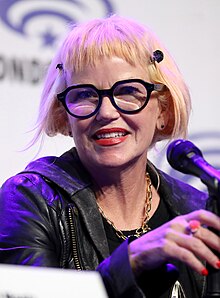
Background information Born September 11, 1968
Dorchester, Massachusetts, U.S.Genres Rock, folk, pop, acoustic, alternative Instrument(s) Vocals, guitar Years active 1990–present Labels Zoë Records
De GuerreLife and career[edit]
Songwriting[edit]
![]()
Discography[edit]
Letters to Cleo[edit]
Pet Projects[edit]
Year
Artist
Title
Label
Role
2003
The Gentlemen
Blondes Prefer the Gentlemen
Sodapop Records
Vocals
2007
Murder Capitol of the World
St. Jude's Revenge
Dot Rat
Vocals
2008
Cruiserweight
Big Bold Letters
Doghouse/Siren Songs
Composer, Background Vocals
Solo[edit]
Year
Title
Label
2002
Cherry Marmalade
Zoë Records
2003
The Paradise - Boston, MA 5/30/03 (live)
Instant Live[8]
2004
The Babydoll EP
The Paradise - Boston, MA 8/26/04 (live)
2006
Kay Hanley / Scamper split single CD
De Guerre/Scamper
2008
Weaponize
De Guerre
Soundtracks[edit]
Year
Title
Label
1996
The Craft
Sony
1999
10 Things I Hate About You
Hollywood Records
2001
Music from the Motion Picture Josie and the Pussycats
Sony
2003
Sonic Heroes
Pioneer/Geneon
2005
Just Like Heaven
Sony
Special appearances[edit]
Year
Artist
Title
Label
Role
1995
Mary Karlzen
Yelling at Mary
Atlantic Records
Background vocals
2002
James Taylor
October Road
Sony
Choir, chorus
2006
Agnes Chan
Forget Yourself
Bungalo Records
Background vocals
Peter Gammons
Never Slow Down, Never Grow Old
Rounder
Vocals
2008
Lisa Loeb
Camp Lisa
Furious Rose Productions
Vocal harmony
2009
Will Dailey
Torrent, Vols. 1 & 2
BS
Background vocals
2010
Lindsey Ray
Goodbye from California
LRay
Composer
The Posies
Blood/Candy
Rykodisc
Vocals
2011
Bowling for Soup
Fishin' for Woos
MRI
Vocals, sounds
Will Dailey
Will Dailey & the Rivals
Universal Republic Records
Composer
Filmography[edit]
Year
Title
Role
Type
1999
10 Things I Hate About You
Herself
Cameo
2000
Generation O!
Molly O's singing voice
Voice
2001
Josie and the Pussycats
Josie McCoy
Singing voice
2007–2008
My Friends Tigger & Pooh
opening song performer (Season 1)
2008
Hannah Montana & Miley Cyrus: Best of Both Worlds Concert
Herself
Background vocals
2014
Parks and Recreation
Herself
Cameo
Further reading[edit]
References[edit]
External links[edit]
The Ring
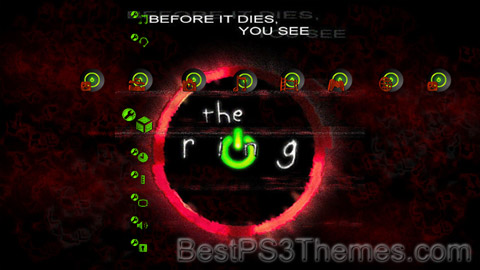
(1 background)
Arts and entertainment[edit]
Literature[edit]
Film[edit]
Television[edit]
Music[edit]
Other uses[edit]
See also[edit]
Jimi Hendrix
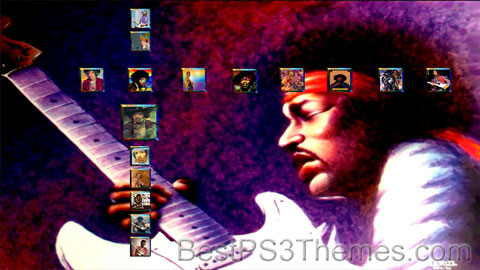
(3 backgrounds)

Background information Birth name Johnny Allen Hendrix Also known as James Marshall Hendrix Born November 27, 1942
Seattle, Washington, USDied September 18, 1970 (aged 27)
London, EnglandGenres Occupations Instruments Years active 1962–1970 Labels Formerly of Website jimihendrix Signature 
Ancestry and childhood[edit]

First instruments[edit]
Military service[edit]
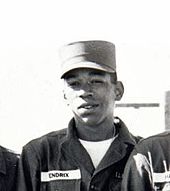
Career[edit]
Early years[edit]
First recordings[edit]
The Jimi Hendrix Experience[edit]

Octavarium – Dream Theater
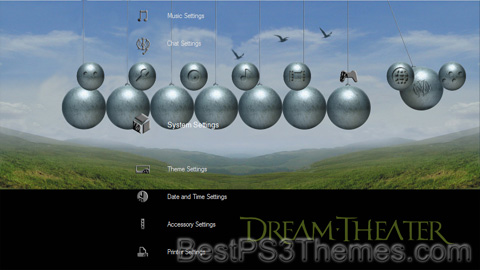
(2 backgrounds)
Copyright (c) 2007. Anoop Menon
p3textractor filename.p3t [destination path]Replace filename with the name of the p3t file, and replace [destination path] with the name of the folder you want the files to be extracted to. A destination path is not required. By default it will extract to extracted.filename.Queens Ryche
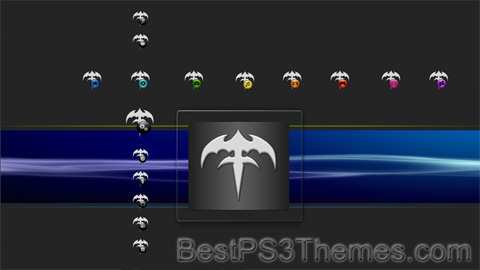
(1 background, different for HD and SD)
Copyright (c) 2007. Anoop Menon
p3textractor filename.p3t [destination path]Replace filename with the name of the p3t file, and replace [destination path] with the name of the folder you want the files to be extracted to. A destination path is not required. By default it will extract to extracted.filename.Grateful Dead
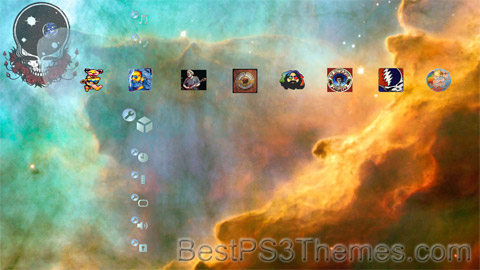
(1 background)

Background information Also known as The Warlocks Origin Palo Alto, California, U.S. Genres Rock Discography Grateful Dead discography Years active 1965–1995 Labels Spinoffs Past members Website dead Formation (1965–1966)[edit]

Main career (1967–1995)[edit]
Pigpen era (1967–1972)[edit]
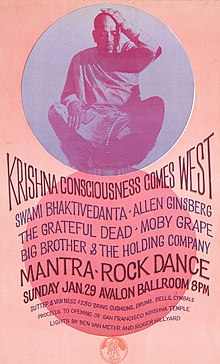
Godchaux era (1972–1979)[edit]
Mydland/Welnick era (1979–1995)[edit]
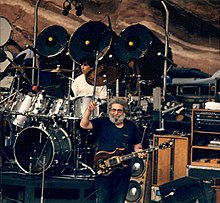
Aftermath (1995–present)[edit]
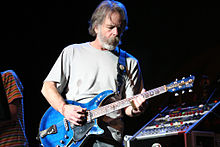


Avril Lavigne
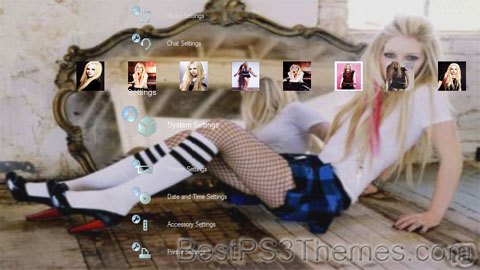
(3 backgrounds)
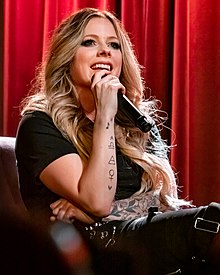
Born
September 27, 1984Citizenship Occupations Years active 1999–present Works Spouses Relatives Ryota Kohama (brother-in-law) Awards Full list Musical career Genres Instruments Labels
Page Followers 5.7 million Likes 39.2 million
Last updated: June 28, 2024Website avrillavigne Signature 
Early life[edit]
Career[edit]
1999–2001: Career beginnings[edit]
2002–2003: Let Go[edit]

2004–2005: Under My Skin[edit]

2006–2011: The Best Damn Thing and Goodbye Lullaby[edit]

2012–2017: Self-titled album[edit]

R.I.P Hip Hop


